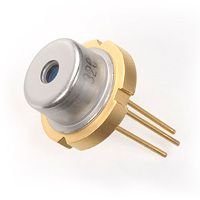第40回電子材料シンポジウム 講演予稿集
オンライン(2021)
Waveguide loss measurements in III-nitride laser structures
Kenta Ogasawara1, Shigeta Sakai2,Tadashi Okumura2, Koichi Naniwae2 and Atsushi A. Yamaguchi1
1Kanazawa Institute of Technology, 7-1 Ohgigaoka, Nonoichi, Ishikawa, 921-8501, Japan
2Ushio Inc., 1-90 Komakado, Gotemba, Shizuoka, 412-0038, Japan
Various types of III-nitride laser diodes (LD) have been developed recent decades, and some of them are now commercially available. InGaN alloy materials are used for active layers in visible-light emitting LDs, and AlGaN alloy materials are usually used for UV-light emitting LDs. It has been pointed out that optical properties of InGaN and AlGaN are peculiar compared with other III-V compound semiconductor alloy materials such as AlGaAs, AlInGaP, and InGaAsP. Especially, it is well known that InGaN quantum well (QW) active layers have very large alloy compositional fluctuation and that density of states (DOS) has a tail with large localization energy. Optical gain characteristics are largely affected by these effects. It has been reported that the gain peak is broaden and differential gain decreased by the fluctuation. However, there is onlya few reports on waveguide loss spectrum in such LD structures.
In this study, we have measured waveguide loss spectrum for an InGaN-QW LD structure. The loss spectrum for a conventional AlInGaP red-light-emitting LD structure was also measured for comparison. Figure 1 shows a schematic diagram to explain the principle of the waveguide loss measurement [1, 2]. When excitation light is focused on the sample surface by object lens at the position where the distance from the sample edge is R, emission light propagates in the waveguide by distance R and emits from the edge. Since a part of the light is absorbed in the waveguide, the edge emission intensity and spectrum will depend on the distance R.
where I is the light intensity of edge emission, and α is the absorption (or loss) coefficient of the waveguide. In this measurement, edge emission intensity & spectrum were measured as functions of distance R, and absorption (loss) coefficient was calculated by Eq. (1) for each wavelength in the QW emission peak.
Figures 2 and 3 show measured waveguide loss spectra (red circles) for a red-light-emitting AlInGaP LD and an InGaN-QW LD. The photoluminescence (PL) spectra from sample surface (green solid line) and sample edge [R = 200 μm] (violet broken line) are also potted.It is observed that PL peakposition difference between the surface and edge emissions is very large (~ 200 meV) in the InGaN LD sample while there is almost no difference in the AlInGaP LD sample. In addition, the absorption coefficient gradually rises from an energy much lower than the PL peak energy of surface emission in the InGaN LD sample while the coefficient sharply rises at nearly PL peak energy in the AlInGaP LD sample. These results show that the InGaN QW has a large DOS tailing while the AlInGaP QW has a step-like DOS.
References
[1]P. C. Mogensen, P. M. Smowton, and P. Blood, "Measurement of optical mode loss in visible emitting lasers",Appl. Phys. Lett.71,(1997)1975.
[2]Dmitry S. Sizov, Rajaram Bhat, Albert Heberle, Kechang Song, and Chung-en Zah, "Internal Optical Waveguide Loss and p-Type Absorption in Blue and Green InGaN Quantum Well Laser Diodes", Appl. Phys. Express 3(2010) 122104.

